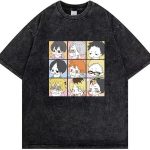I. The Historical Significance of the Kimono
The Artistry of Kimono Making
The traditional kimono dress is a revered art that epitomizes the Japanese dedication to craftsmanship and detail. An authentic robe kimono is composed of a single bolt of fabric known as a “tanmono.” The silk itself is often a work of art, with patterns that may be woven, dyed, painted, or embroidered. The yuzen dyeing technique, in particular, is celebrated for allowing the application of multiple colors and intricate designs, resulting in vivid scenes and landscapes on the garment. Gold and silver threads are sometimes woven into the fabric, representing the epitome of luxury and signifying high status or special occasions.
A single kimono might take weeks or even months to complete, depending on the complexity of its design and the techniques used. Many artisans specialize in specific areas of kimono dress creation, such as the dye masters (some-yashi), textile weavers, or the seamstress skilled in the art of tucks and seams (tate-hida). The collaborative effort results in a garment that is often passed down through generations as a cherished heirloom.

Origins and Evolution
In Japan, the kimono is not merely clothing; it is an embodiment of history, culture, and family legacy. The design, color, and motifs of a kimono often convey stories and messages rooted in Japanese folklore and tradition, signifying a deep connection to the past. People wear kimonos during festivals, ceremonies, and other important life events, with each occasion calling for a specific type and design of kimono, showcasing its deeply entrenched role within the cultural fabric of Japan.
This hands-on tradition of kimono dress faces challenges in contemporary times, as the demand for traditional kimonos has waned and fewer artisans possess the required expertise. However, the Japanese government and cultural institutions have put measures in place to preserve this invaluable craftsmanship, recognizing master kimono artisans as living national treasures and supporting training programs to inspire a new generation of craftsmen and women.
As Japan navigates a path between respect for tradition and the incorporation of modern sensibilities. The kimono remains a powerful symbol. It continues to shape not only the fashion landscape but also Japan’s cultural identity. Reflecting a nation’s prismatic history and its perpetual quest for aesthetic refinement. The future of the kimono depends on this delicate balance, honoring the time-honored methods of its creation while adapting it to the rhythms of modern life and fashion.
Symbolism and Cultural Impact
kimono dress are rich in symbolism, with every hue, pattern, and style conveying specific meanings and stories. For instance, cranes symbolize longevity and good fortune. While cherry blossoms are indicative of the transient beauty of life. The kimono’s significance extends beyond its wear. Serving as a cultural icon that encapsulates the essence of Japanese tradition, respect for beauty, and the changing seasons.

II. The Integration of Kimono in Contemporary Fashion
Kimono-inspired Modern Designs
In recent years, the traditional Japanese kimono has transcended cultural boundaries, deeply influencing a multitude of global fashion designers. This has resulted in the reimagining of the kimono’s silhouette, fabric, and motifs, as they are incorporate into contemporary apparel. This trend has given rise to the prominence of kimono-style dresses, coats, and tops in modern wardrobes. Providing individuals with a fusion of comfort, elegance, and a respectful nod to cultural heritage. By adapting the essence of the kimono, designers have showcased the garment’s versatility and have fostered a cross-cultural appreciation of its aesthetic. Bridging the gap between tradition and modernity in the fashion world.
DIY Kimono Making and Personalization
The do-it-yourself (DIY) movement has wholeheartedly embraced the enduring appeal of the kimono. As enthusiasts experiment with creating their versions using contemporary fabrics and simplified patterns. This trend not only democratizes the women dresses. Making it more accessible to a wider audience, but also encourages personal expression and individuality. The ability to personalize and customize kimonos tailored to individual tastes and sizes has gained momentum, reflecting a harmonious blend of tradition and personal identity. As a result, the rise of customized kimonos within the DIY community captures the spirit of creative expression. While paying homage to the rich cultural heritage associated with this iconic garment.

The Global Appeal and Representation
The kimono’s integration into worldwide fashion showcases its universal appeal. It signifies a broader trend of cultural exchange and appreciation, with people from various backgrounds donning kimono-style garments at weddings, festivals, and fashion shows. The garment has become a symbol of global fashion, representing a confluence of tradition and modernity.
III. The Cultural Significance and Future of Kimono Fashion
Preserving Tradition while Embracing Change
As fashion continues to evolve, so does the role of the kimono within it. There’s a growing movement in Japan and globally to preserve the traditional aspects of kimono culture while adapting to contemporary needs and styles. Initiatives to keep the art of kimono dyeing, weaving, and sewing alive are critical to ensuring that this cultural treasure is not lost.
The Role of Kimono in Promoting Cultural Exchange
The kimono serves as a bridge between cultures, promoting mutual respect and understanding through fashion. By appreciating and wearing kimono-inspired garments, people participate in a form of cultural exchange that transcends language and geography. This exchange broadens perspectives and fosters a global community united by an appreciation for diversity and beauty.

The Future of Kimono in Global Fashion Trends
The continued allure of the kimono in the global fashion landscape speaks volumes about its timeless appeal and adaptable nature. This traditional Japanese garment. With its rich history and deep cultural roots, has the unique ability to transcend geographical and cultural boundaries, captivating designers and fashion enthusiasts worldwide. Its journey from the tightly-knit communities of Japan to the dynamic. Ever-evolving global fashion scene underscores not just a story of a garment but of cultural exchange, creativity, and innovation.
In recent years, the burgeoning interest in sustainable and ethically produced clothing has seen the kimono positioned as a beacon of artisan craftsmanship and environmental consciousness. The traditional methods of creating kimonos, involving natural dyes and hand weaving, resonate with contemporary desires for fashion that eschews the fast. Disposable nature of much of today’s clothing production. As such, the kimono has found new life not just as a piece of attire but as a symbol of a movement towards more thoughtful, sustainable fashion practices.



